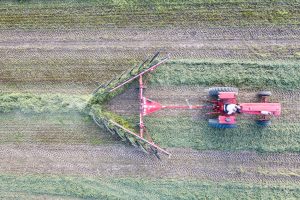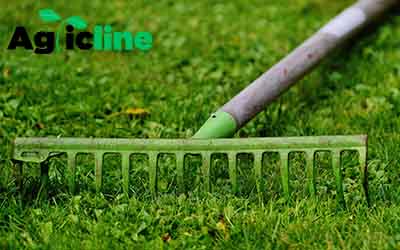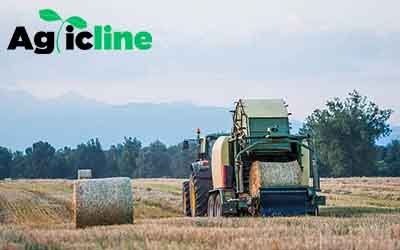In agriculture, a rake is a farm implement used for gathering or arranging cut grass, hay, or other forage crops into rows or windrows.
Rakes are vital tools in the haymaking process, helping farmers efficiently gather, arrange, and prepare the cut forage for further processing. Their role in creating organized windrows contributes to the overall success of the hay production cycle.
They play a crucial role in the haymaking process, helping to gather the dried forage and prepare it for baling or further processing.
Types of Rakes
These are some of the common types of rakes used in agriculture, gardening, landscaping, and construction. The specific type of rake chosen depends on the intended application and the type of material being gathered or manipulated.
There are several types of rakes commonly used in agriculture for various purposes. Here are some of the main types of rakes:
Leaf Rake
Leaf rakes, also known as garden rakes or lawn rakes, are designed for gathering leaves, grass clippings, and other lightweight debris.
They typically have flexible tines made of metal or plastic, which are attached to a long handle. Leaf rakes are commonly used for yard maintenance and landscaping.
Bow Rake
Bow rakes, also called level head rakes or garden rakes, are heavy-duty rakes used for tasks like leveling soil, spreading mulch, or removing rocks and debris. They have a wide, flat head with sturdy tines that are usually made of metal. Bow rakes are commonly used in gardening, landscaping, and construction.
Hay Rake
Hay rakes are specifically designed for gathering and arranging cut grass or hay into windrows for drying or baling.

They have multiple tines or wheels that rotate and gather the material into neat rows. Hay rakes can be wheel rakes, rotary rakes, or parallel-bar rakes, as mentioned earlier.
Landscape Rake
Landscape rakes, also known as soil rakes or rock rakes, have long, sturdy tines that are designed to level and prepare soil for planting, remove rocks or debris, and spread gravel or soil. They are commonly used in landscaping, construction, and agricultural applications.
Root Rake
Root rakes, also called root grapples or brush rakes, are heavy-duty rakes with strong, curved tines that are designed for removing roots, brush, and other debris from the ground. They are often used in land clearing, forestry, and construction projects.
Hand Rake
Hand rakes, also known as hand cultivators or mini rakes, are small-sized rakes designed for use in smaller areas or for more precise tasks. They typically have a short handle and three to five tines, which are ideal for working in tight spaces, cultivating soil, or removing weeds.
Spring Rake
Spring rakes, also called lawn rakes or thatch rakes, have thin, flexible tines that are closely spaced.

They are designed for raking and removing thatch, dead grass, or debris from lawns. The flexible tines allow them to reach down into the grass without damaging the healthy turf.
Functions of rake
The functions of a rake are diverse and adaptable to various tasks in agriculture, gardening, landscaping, and construction.
From gathering and leveling to debris removal and soil preparation, rakes are versatile tools that aid in maintaining, enhancing, and managing outdoor spaces and agricultural fields.
Here are the primary functions of rakes:
- Rakes are primarily used for gathering and collecting materials such as leaves, grass clippings, hay, or debris. They allow for efficient and thorough collection by combing or sweeping the material into a pile or windrow.
- Rakes with sturdy tines, such as bow rakes or landscape rakes, are used for leveling and smoothing surfaces. They can be used to spread soil, mulch, or gravel evenly over an area, ensuring a smooth and even finish.
- Rakes, particularly landscape rakes or hand cultivators, are employed for soil preparation tasks. They can break up clumps, remove rocks and debris, and create a fine, level surface suitable for planting or seeding.
- Spring rakes or thatch rakes are specifically designed to remove thatch, which is a layer of dead grass, leaves, and other organic matter that accumulates on lawns. These rakes help to improve the health and appearance of the turf by allowing air, water, and nutrients to reach the grass roots.
- Rakes such as hay rakes are used in agriculture for harvesting and windrowing crops like hay or forage. They gather the cut material into neat rows or windrows, facilitating the drying process and preparing the crop for further processing, such as baling.
- Rakes are effective tools for clearing and removing debris from various surfaces, including lawns, gardens, and construction sites. They can help gather sticks, branches, stones, or other unwanted materials, making the area clean and safe.
- Rakes are handy for garden maintenance tasks, such as smoothing soil in garden beds, removing weeds, and distributing compost or mulch evenly.
- Rakes are often used in landscaping projects for tasks like creating patterns or designs in soil, spreading ground cover, or grooming gravel paths.
Parts of rakes
It’s important to note that the specific design and composition of rake parts can vary depending on the type and brand of the rake. Different types of rakes may have additional features or variations in their parts to suit their intended functions.
- Handle: The handle, also known as the shaft or grip, is the long, straight component of the rake that allows for holding and maneuvering the tool. It is usually made of wood, fiberglass, or metal and provides a comfortable grip for the user.
- Head: The head of the rake is the main working part that contains the tines or teeth. It is typically made of metal, plastic, or a combination of both. The head can vary in shape and size depending on the type of rake.
- Tines or Teeth: The tines or teeth are the pointed or curved components that extend from the head of the rake. They come in various lengths, thicknesses, and spacing, depending on the rake’s intended use. The tines gather, collect, or level the material when the rake is in use.
- Ferrule: The ferrule is a metal or plastic collar that connects the head of the rake to the handle. It provides reinforcement and stability to the rake, preventing the head from loosening or detaching during use.
- Connection Point: The connection point is where the handle and head of the rake are securely attached. It can be a socket or a hole in the head of the rake that accommodates the handle, or it can be a screw or rivet that fastens the handle to the head.
- Brace: Some rakes, particularly larger or heavier-duty models, may include a brace or support that reinforces the connection between the handle and the head. The brace adds strength and durability to the rake, especially when dealing with heavier materials.
- Grip or Cushion: Some modern rakes feature grips or cushions on the handle for added comfort during use. These grips may be made of rubber or foam and provide a non-slip surface, reducing strain and fatigue on the hands.
Maintenance of rakes
By following these maintenance practices below, you can extend the lifespan of your rakes, ensure their reliable performance, and promote safe and efficient use. Properly maintained rakes contribute to the effectiveness of your gardening, landscaping, or agricultural activities.
Here are some maintenance tips for rakes:
- After each use, remove any debris, grass clippings, or soil that may have accumulated on the tines or head of the rake. Use a brush or hose to clean the rake thoroughly. This prevents the buildup of corrosive materials and keeps the rake in good condition.
- Regularly inspect the rake for any signs of damage, such as bent or broken tines, loose handles, or cracked heads. Replace or repair damaged parts promptly to avoid further deterioration and ensure safe and effective use.
- Over time, the tines of the rake may become dull or worn out, especially in rakes used for heavy-duty tasks. Sharpen the tines using a file or replace them if they are too damaged or ineffective. Sharp tines improve the rake’s efficiency and make it easier to gather and collect materials.
- Ensure that the handle is securely attached to the head of the rake. Tighten any screws or fasteners if they become loose. If the handle is damaged or weakened, consider replacing it to maintain the stability and functionality of the rake.
- When not in use, store rakes in a dry and protected area to prevent rusting and deterioration. Hang them on a wall or place them in a shed or garage where they are not exposed to moisture or extreme temperatures.
- If your rake has any moving parts, such as hinges or adjustable mechanisms, lubricate them with a suitable lubricant to ensure smooth operation. This helps prevent rust and prolongs the lifespan of the rake.
- Avoid using rakes for tasks beyond their intended capabilities, as this can lead to damage or breakage. Handle the rake with care, avoiding excessive force or misuse that could bend or deform the tines or head.
- Establish a regular maintenance schedule for your rakes, taking into account the frequency of use and the conditions they are subjected to. Perform routine inspections, cleaning, and repairs as needed to keep your rakes in optimal condition.



